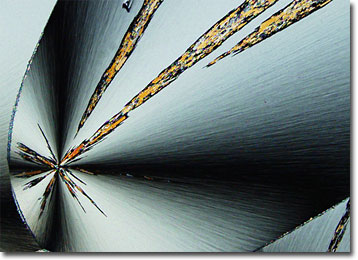Polarized Light Microscopy Digital Image Gallery
DDT
DDT is an organochlorine insecticide that was once acclaimed for saving millions of lives by eradicating disease-carrying insects, but has since been banned by the United States and many other countries. Indeed, few other chemicals in existence have undergone such a profound turnaround in their public perception and use in such a short period of time.

Though a German graduate student first synthesized it in 1873, DDT was not used as an insecticide until it was rediscovered by Dr. Paul Mueller, a Swiss entomologist searching for a long-term solution to the clothes moth, in 1939. When further research demonstrated that the synthetic chlorinated hydrocarbon was also effective against flies, lice, and mosquitoes, the military realized its potential for protecting troops against insect-borne diseases during World War II. Then, in 1948, after the substance was credited with staving off countless outbreaks of malaria, typhus, and related illnesses, Mueller was awarded the Nobel Prize in medicine.
In the years following the war, DDT became increasingly popular in the private sector, homeowners frequently using it to spray their yards. Soon, however, insects began showing resistance to the long-lived chemical and concerns about its effect on the environment began to surface. Some reports pointed out that the fat-soluble substance bioaccumulates in the environment and could wreak havoc on the food chain, but it was not until Rachel Carsonís landmark book Silent Spring was published in 1962 that the public truly took notice of the situation. The text, which blamed DDT for the disappearance of songbirds and other environmental problems, caused an outcry against the chemical and spurred the environmental movement. By 1973, DDT was banned in the United States and several other countries have since followed suit.
